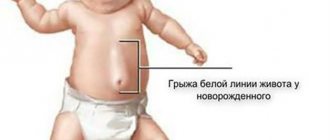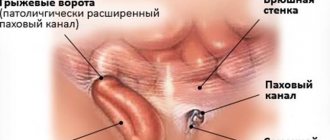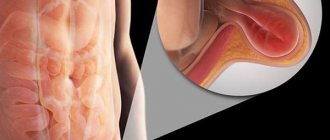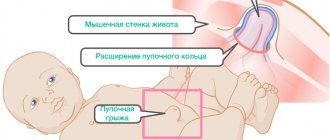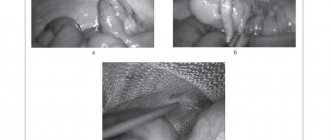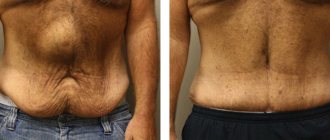Surgery for umbilical hernia: indications, techniques, rehabilitation
An umbilical hernia is a pathology in which internal organs (or fatty tissue) extend beyond the anterior abdominal wall through the navel. This disease is very common in children: in approximately 20% of newborns, it is noteworthy that this pathology is more common in girls.
An umbilical hernia in an adult is a direct indication for surgical intervention. Speaking of children, it is worth noting that in 90% of cases, umbilical hernias close on their own. However, in some cases, surgical treatment is still necessary: this applies to children over 6 years of age and younger patients who have been diagnosed with giant and strangulated umbilical hernias.
Specialists from the First Children's Center will talk about the causes of the pathology and the procedure for surgical treatment of this disease.
Is it worth the surgery?
The doctor will suggest performing hernia repair surgery only if the child’s umbilical hernia has not regressed by the age of 7. For an infant, surgery is performed only if the hernia is strangulated.
If strangulation occurs and the child is taken to the emergency surgery department, then doctors will most likely use a modern technique - hernioplasty, during which it will become clear whether the organs trapped inside the hernial sac can be saved. If they are damaged, you will have to choose removal; if there is no such problem, the hernia will be surgically reduced and the hernial ring will be sutured. To securely fix the ring, surgeons use either the child’s own tissue or an implant made from a special mesh. In addition to standard open surgery, parents may be offered the option of laser surgery.
Causes of umbilical hernia
An umbilical hernia in a child can occur for a number of reasons, for example due to:
— weakened abdominal wall muscles;
- low weight and prematurity;
— diseases of the gastrointestinal tract;
- frequent constipation, etc.
With this disease, the child does not experience pain, but colic and bloating in this case are more difficult for babies to tolerate. A small hernia may disappear on its own during the first year of a child’s life. If this does not happen, the child must be observed by a pediatrician and surgeon until the age of 4 years. If the hernia has not disappeared by this time, then surgery must be performed before reaching the age of 5. Surgical treatment of an umbilical hernia allows you to completely get rid of the problem. This operation is not only highly effective, but also safe, since the likelihood of developing any complications is practically excluded (complications are less than 1%). Most children easily tolerate surgery for umbilical hernia.
Is it possible to cure a hernia in an infant?
An umbilical hernia in an infant is not a simple diagnosis that requires mandatory monitoring of the child. However, in most cases (95%) until the child reaches one year of age, doctors prefer watchful waiting rather than any other intervention. As for the specific fight against a hernia, today the only option for getting rid of the pathology is herniotomy - an operation to remove a hernia. For infants, such a decision is made by the doctor only in the event of a strangulated hernia. And in the vast majority of cases, the doctor suggests that parents wait until the pathology begins to regress and completely disappear.
To help this happen, you can carry out certain manipulations at home, without the use of pharmaceuticals. It will be enough to closely monitor the child and use some techniques that will gradually help the process come to naught.
These include the following measures:
Application of the patch . This method is often used, but when choosing it, certain rules must be taken into account. Before applying the patch, the hernia must be repaired (preferably with the help of a specialist, since illiterate actions can lead to spasm of the umbilical ring and subsequent pinching of the hernia). Contact a surgeon: he will quickly and correctly repair the hernia and instruct you on how to do it manually. Next, the doctor will explain how to correctly apply the patch so that the hernial sac is fixed safely and reliably. After consultation, parents can change the patch themselves: they will be sure to monitor for allergic manifestations or local inflammation. The doctor will warn you in advance when it is necessary to show the child to monitor his condition. If the doctor notices an increase in the hernia, most likely he will offer you another method of fixation. When choosing a patch, parents should read the instructions for it very carefully: it is necessary that the product is sterile, hypoallergenic and of high quality. After each bath, the baby needs to re-fix the hernia formation.
Wearing an orthopedic belt . The bandage is more convenient and reliable, unlike a plaster: it helps to secure the hernial formation well so that it is located inside the peritoneum and in the correct position. At the same time, the orthopedic belt stabilizes the balance between external resistance and internal pressure. But since the use of a bandage also requires special rules, consultation with a specialist will be necessary. The surgeon will also first reduce the mass and then show you how to put on the belt and secure it.
The children's bandage will not cause discomfort to the baby, since it is made of elastic soft fabric. As a rule, no items of clothing are worn under the belt, and special hygiene pads are included with the product for the genital area. If the hernia is small in size, then a couple of months of wearing the belt will be enough, and you will notice that the hernia has practically disappeared. The only contraindication for wearing a bandage may be dermatological problems in the area where the belt is adjacent to the child’s skin. Be sure to inform your doctor if your baby has eczema, allergic or infectious rashes in the area where the bandage is applied.
Exercises and massage . After a simple consultation, the mother will be able to give the baby with a hernia a beneficial massage and special exercises. Ask your surgeon or local pediatrician to show you massage techniques and techniques specifically for this case. The main rule when carrying out the procedures will be gentleness - the main movements should be carried out in a circle in the navel area. In addition, it will be useful to place the baby on his stomach so that he gradually strengthens both the oblique abdominal muscles and the abs. Rolling over onto your side while lying on your back will also help create a muscle corset: to stimulate the child to turn, you need to pull his hand a little. General strengthening gymnastic exercises are bending the legs with adduction to the stomach, arching the legs, simple flexion and extension. It is better to do such exercises with your baby in the morning, and massage before feeding, since after feeding, massage movements can cause regurgitation.
Folk methods . Despite the fact that many grandmothers recommend “treating” a hernia by tying a coin to the navel, this method can seriously harm the child, not to mention the fact that it is absolutely useless. Firstly, the hernial sac cannot be fixed well with a coin, and secondly, infection in the navel area has a really high chance. And considering that nowadays there are no problems with buying a bandage or patch, it is much safer to use them. No less useless are the recommendations of smearing the navel with propolis or butter and giving the child a decoction of rhubarb. It is possible that the baby will develop an allergy to these drugs, and then problems will increase.
Indications for surgical treatment of umbilical hernia in children
The method of treating an umbilical hernia is determined by a pediatric surgeon. A referral for surgery is issued by a doctor in the following cases:
1. Umbilical hernia in a child over 6 years old. This pathology has the potential to heal itself, however, if this does not happen before reaching 6 years of age, surgical intervention is mandatory.
2. The hernia is large. If the diameter of the umbilical hernia is more than 1.5 centimeters, the operation is performed from 3 years, since hernias of this size almost never close on their own.
3. The hernia has a trunk-shaped structure. Proboscis hernias also do not tend to heal on their own, so children with this pathology are operated on as early as 1 year.
4. Complicated umbilical hernias. Complications are usually associated with organ infringement. Injury to internal organs is considered an acute situation that requires urgent surgical attention.
Hernia in newborns: symptoms
Congenital hernias formed in the mother's womb will be detected by a doctor who will diagnose the pregnant woman during a routine ultrasound in the antenatal clinic or already in the maternity hospital. As a rule, such pathologies are not mild, because the birth defect is quite extensive. Usually, with a congenital hernia, the sac contains several organs at once (liver, several intestinal loops, omentum), and the pathology itself can be aggravated by genetic problems and diseases.
Acquired umbilical hernias in newborns are not so dangerous to the life and health of the baby, and most often there is a chance to get rid of the pathology. A diagnosis of a hernia can be made a month after birth: by this time, the umbilical wound has already healed, and the hernia formation becomes noticeable. True, this does not always happen, because an umbilical hernia can form or become noticeable at a later time: even in a 3-6 month old child, this risk exists. Therefore, it is very important to diagnose a hernia in a baby in time and take the necessary measures to prevent complications from occurring.
How can parents recognize a hernia on their own? The pathology is always localized in the area of the umbilical ring. It looks like a round, oval or arbitrarily shaped knot, the size of which can be either very small (0.5 cm in diameter) or very large (5-6 cm in diameter).
If the hernial sac contains only intestinal loops, then the hernia will have a bluish tint, and an attentive parent will be able to see the intestinal wall through the baby’s thin skin. If the hernial sac contains the liver or omentum, the hernial formation will take on a reddish tint. Of course, such a picture can frighten an unprepared parent, but there is no need to panic, since your baby will not experience pain, itching or other uncomfortable sensations.
It is not difficult to visually notice an umbilical hernia in a newborn at moments when the baby is tense - crying, coughing, when he has a bowel movement. But in moments of calm and relaxation of tension, the hernia becomes almost invisible. If you lightly press your finger on the hernial formation, it will most likely go into the abdominal cavity, but then return to its place again. Some doctors believe that the baby’s digestion and behavior largely depend on the presence of a hernia, explaining the presence of the pathology as lack of appetite, poor sleep, and frequent regurgitation. But most experts do not agree with this theory, since in completely healthy babies, sleep and appetite no less often deteriorate, and frequent regurgitation is usually a symptom of overfeeding. Hernial formation also has no effect on the occurrence of constipation, colic and other common problems in newborns.
But you should pay special attention to the acute symptoms of an umbilical hernia in newborns, since they can be directly related to a strangulated hernia: in this case, the child experiences severe abdominal pain, vomiting and serious bloating may begin. This condition occurs when the umbilical ring is strongly compressed, and feces accumulate in the intestinal loops located inside the hernial sac. The hernial sac remains in the ring outside along with the intestinal loops sandwiched in it, which cease to be supplied with blood. This position causes very severe pain in the baby, he screams and is unable to straighten up. If you pay attention to the external state of the hernia, it is critically tense, as if overfilled, and cannot be inserted inside (you should not even try to do this). In this case, the baby needs urgent surgical care: you should call an ambulance as soon as possible and report a strangulated hernia.
Preparing for surgery
As noted earlier, most surgeries for umbilical hernia are performed before the age of 5 years. Before the actual operation, the child is sent to preoperative preparation, which includes:
— consultations with a pediatrician and surgeon;
- general blood analysis;
— determination of the Rh factor;
- general urine analysis;
— biochemical analysis;
— ECG.
After the child undergoes preoperative preparation, an anesthesiologist consults with the baby’s parents. The operation is performed under general anesthesia.
Which doctor deals with umbilical hernia?
A child with a hernia should be consulted with a pediatric surgeon. His task is to conduct an initial examination and make a qualified decision about whether surgery is needed in this case and, if necessary, when. The fact is that in almost 90% of cases the problem disappears with age on its own, without surgical intervention. Closing the umbilical ring is facilitated by infant massage and physical therapy. If the problem does not go away on its own, the operation is usually performed at the age of 5-6 years, before school.
It is almost impossible to miss an umbilical hernia, since in the first year of life the baby must visit a pediatric surgeon at least 2 times (at 1 month and at 12 months).
Is it necessary to operate on an umbilical hernia in a child?
During routine visits, the doctor performs a visual examination and palpation of the hernia. Each case has its own anatomical features, and the decision on surgical intervention should be made only by a competent pediatric surgeon! The size of the hernia and its structure are critical.
The main indication for hernioplasty in a baby is complications caused by an umbilical hernia: strangulation, tissue rupture. They are very rare. If the patient does not experience discomfort or pain in the abdominal area, he is less than 5 years old, and the bulge is small, then the likelihood of spontaneous closure of the ring remains, and the decision about surgery is postponed to a later date.
However, if the child has already turned 5, and it has not disappeared, most often surgery is still recommended. The same operation in a person over 14 years of age is more difficult.
Carrying out the operation
At the First Children's Medical Center, it is possible to perform an operation using open access (through an incision in the abdominal wall).
During the operation, the surgeon excises the hernia and pushes the contents into the abdominal cavity. Then manipulations are carried out with the tissues of the umbilical ring (strengthening the tissues to prevent relapse). After this, the navel is given an aesthetic appearance. As a rule, this type of operation lasts no more than half an hour.
Where to operate on an umbilical hernia in a child?
This operation is performed in many state children's hospitals: Filatovskaya, Morozovskaya, St. Vladimir, them. Speransky. Most often, it is done in a hospital for one day, and the child is discharged home on the same day. The operation itself lasts about 20 minutes. 7-10 days after discharge, the little patient remains at home under observation, and then comes to the hospital to have the stitches removed. Complications from navel surgery are extremely rare.
The greatest problem for parents of preschool children, as a rule, is the postoperative restriction of physical activity of the operated patient, since the children themselves are ready to run, jump and lift weights as soon as they feel better. Unfortunately, there is no magic recipe: the only way out is to stock up on materials for quiet games in advance and constantly talk to your child about why he needs to be careful. Fortunately, the recovery period after hernia removal in children takes less than a month.
Rehabilitation period
This operation belongs to the so-called outpatient surgery. After direct surgery, the child spends 6 to 12 hours in the hospital, after which he is sent home. Before discharge, it is imperative to consult with your doctor to receive recommendations for caring for your child. It is very important to clean the wound daily and keep it clean. After a week (or 10 days), you must come to the Center to remove the stitches and observe the surgeon. It is worth noting that the rehabilitation period is quite easy, since almost all children tolerate such surgical procedures well.
To prevent a hernia from occurring in an infant: preventive measures
- do not allow the child to cry hysterically and for a long time;
- prevent constipation, if you are prone to it, use an enema, a gas tube, consult a doctor to see if you can use a mild laxative;
- avoid bloating; if your baby often has colic, use products that will reduce gas formation;
- attend swimming lessons with your child from an early age (as a rule, modern sports clubs offer classes from 2 months of age), this helps strengthen the muscles of the abdominal wall;
- Contact your ENT doctor promptly to prescribe cough medicine if your child is sick;
- when playing with your baby, do not throw him up: this increases internal pressure in the peritoneum;
- Don't swaddle your baby too tightly.
Advantages of umbilical hernia treatment at the First Children's Medical Center
The first children's medical center is equipped with modern equipment. Advanced technologies are used during operations. All this, coupled with the experience of our doctors, allows us to reduce the risk of developing any complications, as well as the traumatic nature of interventions, to almost zero.
The health of your child should be entrusted to professionals. If the first symptoms occur, consult a doctor! At the First Children's Medical Center, experienced doctors will quickly recognize the signs of the disease, conduct a full examination using modern medical equipment and provide qualified medical care. We work seven days a week and are waiting for you at any time from 8.00 to 20.00.
Make an appointment with a surgeon
Choose a doctor
